|
FAQs about Live Rock Hitchhiker/Creature
Identification
21
Related Articles: Live
Rock, Reef Systems, Refugiums,
Related FAQs: Live Rock, Answering
Some LR FAQs by James Fatherree, LR
Hitchhiker ID 1, LR Hitchhiker ID
2, LR Hitchhiker ID 3, LR Hitchhiker ID 4, LR Hitchhiker ID
5, LR ID
6, LR ID 7, LR ID 8, LR ID 9,
LR ID 10, LR
ID 11, LR ID 12, LR ID 13, LR ID
14, LR ID 15, LR ID 16, LR ID17,
LRID 18, LRID
19, LRID 20, LRID 22, LRID
23, LRID
24, LRID 25, LRID 27, LRID 28,
LRID 29,
LRID 30, LRID 31,
LRID 32, LRID 33,
LRID 34, LRID 35,
LRID 36, LRID 37,
LRID 38,
&
Non-Vert IDs 1, Tubeworm ID, Polychaete Identification, Live Rock 1, LR 2,
LR 3, LR 4,
LR 5, Curing
Live Rock, Live Rock Selection,
Shipping/Moving, Placement, Lighting, Water Quality, Live Rock Studies in Fiji Collaboration
& Charts, Copper Use, Marine
Landscaping, Marine Biotope,
Sumps, Refugiums, Faux
Rock,
|
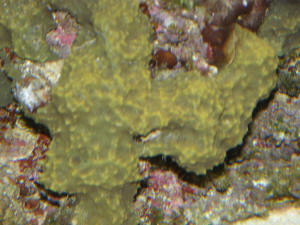
|
|
Identification
Aquarium Inhabitants ID 11/22/09
Hello Crew!
< Hello! >
I'm helping a friend re-do his reef (its quite a mess). I
have taken some photos of some things I have not seen in aquaria
labeled A, C, D, E.
< No "B" ? >
Just wanted to know what the things in question are before we
start taking apart the tank and redoing it.
Whether to keep or discard them in the new setup.
< OK, let's take a look.>
Attached is a pic.
< "A" - Apperas to be Acetabularia Aka Mermaids
Wineglass. Acetabularia is one of the more desirable algaes
available in the hobby and a personal favorite of mine.
" B " - Did we forget the "b" ?
" C " - Halimeda.
" D " - Looks like Caulerpa racemosa Aka Grape
Caulerpa. It can become a real nuisance if not closely
watched.
" E " - This one is hard to determine from the picture.
Looks like some type of polyp.
Read here for more info on the algaes
http://www.wetwebmedia.com/greenalg.htm
Thanks in advance!
< You welcome GA Jenkins >
|
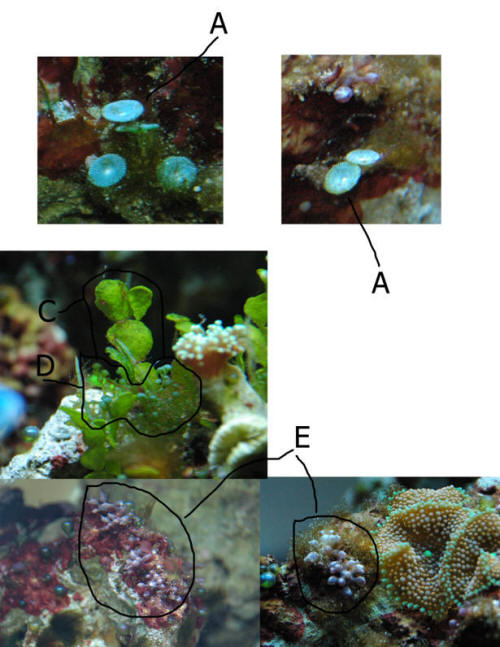 |
|
Re: Aquarium Inhabitants ID
11/23/09
B? never seen that symbol. Is that part of our alphabet?
LOL...There was a B pic but I took it out and didn't want to
re do everything to accommodate the correction (I had flattened
the file in Photoshop).
Thanks for the help!
< '¹B'º is the second letter in the Latin
alphabet. Its name in English (pronounced /ËbiË/) is
spelled bee, plural bees.[1] It is used to represent a variety of
bilabial sounds (depending on language), most commonly a voiced
bilabial plosive.
I'm not just an aquarium guy, I'm a comedian too!
Your very welcome. GA Jenkins >
|
|
What is it?? Nyet! 11/19/09
What is the anemone looking thing in the close up of the larger
picture, also what is all this hard white stuff?
<Where are folks manners? What re following instructions? You
sent some 15 megs in pix? Yes... no!
The first is a Corallimorph, a Pseudocorynactis sp.. See here:
http://wetwebmedia.com/mushridf3.htm
and the linked files above. The white bits are Serpulid worms...
Now get going on reading! Sheesh! And I mean, sheesh!
Bob Fenner>
|
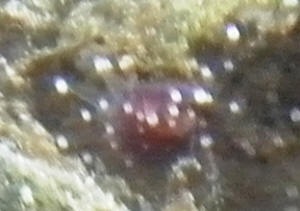 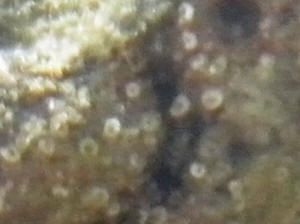 |
Bubble tip anemone....a hitchhiker? 11/11/09
Hello everyone.
I bought a yellow Pavona coral about a year ago from my local pet
store. It didn't seem to have any other live items on it. About six
months ago we noticed these little tentacles coming out of the middle
of the coral. It got bigger and bigger and now it has a 2 inch
diameter. It has green tentacles and tan bubble tips and it looks just
like one of the pictures for a bubble tip anemone you guys have on the
site; so I guessed it to be a
bubble tip.
<Possibly>
But my question is how did it get in my tank? If it came with the
Pavona coral then how come it took 6 months for it to come out? Any
ideas? I appreciate your help. Thanks for all the good information
available on this site.
<Such hitchhiking events are not uncommon. And sometimes, as in your
case here, do occur over a delayed period of time from introduction.
Only takes a wee bit of tissue for Cnidarians, including Anemones, to
regenerate individuals. This is part of the great enjoyment of our
hobby; the discovery of new life! Cheers, Bob Fenner>
Unknown pests/Tube Worms -- 11/09/2009
Good Morning,
<Hey Steve! JustinN here>
Recently in my 65 gal. reef tank I have noted several tube shaped
animals growing from the rock. They all start as small tubes approx.
3-4 mm in diameter, slowly growing in length, but not diameter. In the
"mouth" there are two small antennae/feelers that extend and
a small mouth can be seen occasionally.
<Ahh yes, common Polychaete tube worms -- common hitchhikers of live
rock.
Have a read here: http://wetwebmedia.com/feather.htm>
They are not bothering anything else in the tank except they are
constantly releasing a very fine thread-like substance that attaches to
the rock and corals.
<Feeding appendages, yes>
It looks as if I have marine spiders in the tank. I am unable to
provide a photo as our card reader has died.
<Mmm, not needed -- very common.>
Any chance you have come across a creature like this before? Should I
attempt to remove them? Your help is always greatly appreciated
Steve
<These are beneficial (and free!) creatures that will help filter
out further wastes from your tank, similar to the other benthic life
provided by live rock in a marine environment. They are harmless,
though don't be
afraid to remove some if they are disturbing the natural view of your
aquarium. -JustinN>
|
Neon Orange Bubbles? 11/9/09
Hello, I was Wondering if you can tell me what this could be?
These bubbles pop up neon orange then in a day turn into a deep
red bubble.
Thank you.
Meagan
<Very interesting... something that is generating gas,
enclosed within the colony... Would you please send along a
better resolved (close-up) image?
Bob Fenner>
|
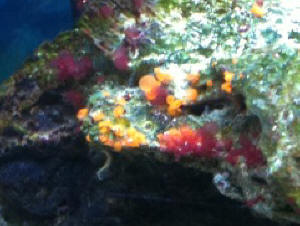 |
Fluffy beige stuff, LR HH ID f' -- 11/03/09
Hi Guys,
<And Gals Nan>
I have looked over your site as best I can as it is one large and
informative place and have not been able to find an answer. My guess is
that it is there but I am not computer savvy enough to pull it up
:(.
<Wish I was better at making all more easily available>
I have a 180 gal reef tank that has been up and running for several
years now. I have had some problems off and on but have been able to
resolve most of them, up until now. A brief rundown : Eco system
filtration, Tunze circulating pump, small Red Sea skimmer, well water
run through Kati/Ani system. Livestock of several soft corals- the
mushrooms thrive, a few stonies, one large Sebae anemone, a few feather
dusters and some sponges that hide under the rocks. 6 large fish and
several smaller ones. Misc crabs and snails and a few small bristle
worms. I trapped the jumbo ones out some time ago. Water parameters:
SpG 0.024, <1.024> ph 8.3, Alk 4meq, ca 450, the rest 0 with use
of Tropic Marin Pro salt.
For a couple years I have noticed what looked like minute soft
'antlers' on the underside of the rocks. As they didn't
seem to hurt anything and would be difficult to remove I left them
there. Recently I have noticed a beige sediment occurring on the top of
the rock along with these fuzzy antlers. I can blow the sediment off
and it turns the water murky but the antlers stay. I have tried to suck
it off with water changes but that is
impractical as the corals get in the way. I thought about tearing the
whole thing down, cleaning it and starting over but that seems a bit
drastic. I did attempt to take a pic for you but it didn't really
show much.
Any idea what I may be dealing with and how to get rid of it?
Thanks,
Nancy D
<Mmm, best guesses are either some sort of sponge life, or an
algae... Neither are really detrimental, may well be beneficial in many
ways/aspects, and I would leave them in place. Just "blow
water" about these areas during water change-outs. Bob
Fenner>
Re: fluffy beige stuff 11/3/09
I can do that. In fact, it sounds like a quick and simple fix.
Thanks,
N
<Ahh, welcome Nan. BobF>
|
Live Rock Hitchhikers: Chiton and Whelk --
10/9/09
<Hello Glenn, Lynn here this evening.>
I was hoping you could confirm a couple of live rock hitchhikers
and maybe give some more information.
<Will sure try.>
Currently I got 50 lbs. of live rock curing in quarantine and I
came across these two beauties.
<Neat! The pinkish, mottled, low-rider is a beneficial,
herbivorous Chiton. The black and yellow snail is a whelk of some
sort.>
Should I remove them or are they reef and invert safe?
<Keep the Chiton, lose the whelk.>
This rock will eventually end up in my 180 gallon tank with fish,
squamosa clam, diadema urchin, snails, Acropora and Montipora
coral.
<Nice!>
I believe one is a flat worm maybe a Polyclad but not sure.
<Good news, it's not! It's a neat little Chiton
(Polyplacophoran). For more information, please see the following
link:
http://bb.wetwebmedia.com/viewtopic.php?f=25&t=298&p=3108&hilit=chiton#p3108
>
The other is a snail in the Buccinidae family.
<Oh yes indeed. It's a whelk alright, and very similar to
one I've seen before. It's in the family Buccinidae
Pisaniinae, most likely in the genus Engina (Pusiostoma), and I
wouldn't trust it around a corner. Please see the FAQ titled
'Black and yellow snail ID: Engina (Pusiostoma) sp. -
5/2/08' at the following link for more information and a
photo: http://www.wetwebmedia.com/snailid16.htm
Here are two possibilities (knowing location of origin will help
rule in/out possibilities): Engina histrio:
http://www.gastropods.com/0/Shell_53500.shtml
Or Engina alveolata fusiformis:
http://www.gastropods.com/0/Shell_20970.shtml
More from this genus at this link:
http://www.gastropods.com/Taxon_pages/TN_Family_BUCCINIDAE_PISANIINAE.shtml >
In addition I have about ten Aiptasia or Anemonia that I've
got to get rid of
<Good thinking - get rid of any pest anemones now.>
..and identify three little crabs.
<Next time you see them, count the walking legs. Do they have
three on each side plus two claws, or four on each side (plus
claws)? In general, three legs = porcelain crab of some sort and
not likely much of a problem. Four legs = true crab and a
potential concern. If you can get some good photos, do send them
along and we'll take a look. If possible, leave the crab
submerged in tank/container while photographing. Include a shot
from above showing the carapace and all legs, and one from the
front showing the claws. You can learn a lot about a crab from
just looking at those claws!>
All I can say is quarantining my live rock has saved me a ton of
trouble down the road.
<You are wise, grasshopper! Good luck and enjoy!>
Glenn
<Take care, LynnZ>
|
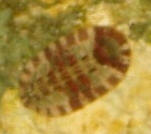 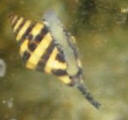 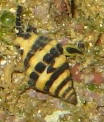 |
Saltwater Hitchhikers - Wanted or Unwanted? - 10/07/2009
re: saltwater PESTS :-(
Hi
<Hey there!>
I got 60 pounds of live rock from a friend these rocks were in his tank
for about 2 years. I placed them in my tank about 2 months ago and this
is where it all starts. I have noticed many little white
snails, AIPTASIA, Hydroids, BRISTLEWORMS, SPIONID WORMS, AMPHIPODS,
COLLONISTA SNAILS or maybe SUNDIAL SNAILS.
What do you recommend, should i clean out the tank and start all over
again or .... ? Please advise.
<Mmm, I would not. Most of the things you have listed are a good
thing, and will not be a detriment to your tank -- the small white
snails, the bristleworms, the Spionid worms, amphipods, and Collonista
snails are all
welcome visitors and will help with detritus removal from the tank. The
Hydroids, aiptasia and sundial snails can be problems, but can be
treated -- read here:
http://www.wetwebmedia.com/marine/inverts/cnidaria/anthozoa/aiptasia/aiptasia.htm
http://www.wetwebmedia.com/hydrozoans.htm
http://www.wetwebmedia.com/pestsnailfaqs.htm and related links
above.
-JustinN>
My tank 90 gallon about 3 months old
also 90 gallon sump in the basement, deep sand bed and Chaeto in tank i
got
2 clown
1 Chromis
1 yellow tail damsel
1 blood shrimp
1 cleaner shrimp
2 peppermint shrimp
1 fox-face
10 mixed snails
1 mushroom
1 polyp
1 zoo
1 hammer head
Thanks
Dan
|
Sponge I.D. 9/28/09
Hi Crew,
Have a sponge id I'm hoping you guys can confirm or help with
a kick in the right direction. I know they're hard to id due
to the 1000's of species, but after scouring databases and
WWM, I believe this to be Spirastrella vagabunda.
<Mmm... I don't think so, but...>
I have thought this from their first appearance on the new live
rock, but they have spread to 50% of the live rock(colonies
approximately the size of quarters and dimes) in a 55 gallon
aquarium in less than 3 weeks. I wasn't aware of this species
reproducing at such high rates.
Hopefully the pictures aren't absolutely horrible. I'm an
avid diver and aquarist.... but a HORRIBLE photographer. Any help
would be appreciated.
Thank you.
--
~ Glenn
<Your pix show definitely some sort of sponge, but also I
think an encrusting algae... Definitive ID to at least Class...
could be done with a simple microscope and reference. Bob
Fenner>
|
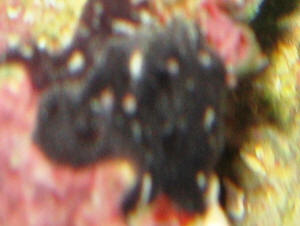 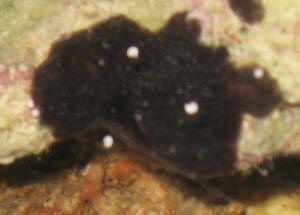 |
|
Re: Sponge I.D., control
9/29/2009
Mr. Fenner,
Thank you for the quick response. I have "Systema Porifera:
A Guide to the Classification of Sponges"
<!? Wow:
http://www.amazon.com/Systema-Porifera-Guide-Classification-Sponges/dp/0306472600
Have you a 'scope?>
and a couple of pocket reef guides by Ned DeLoach, but have found
nothing that really identifies the sponge beyond class,
Spheciospongia. My concern is that the rate of growth I am seeing
is an indication that this is an unwanted organism in my
systems.
<A subjective evaluation... but do agree with you concerning
overgrowth... Can be undesirable>
Any opinion there?
<Rock removal and careful scrubbing... or more extreme...
bleaching, rinsing, air-drying>
The 55 gallon containing my new spongy critters is only used for
qt of rock and seeding rock. Thank you again.
Glenn Fritz
<Oh... bleached rock can be reinoculated with some new placed
about... BobF>
|
|
Growth on Rocks 9/16/09
I have a greenish encrusting substance growing and spreading on
my rocks.
<I see this...>
It was recommended that a pencil urchin be introduced to
eliminate it.
<Nah... not an algae; even if so, not all are
palatable...>
The urchin has been in the tank for 2 months and will not touch
it. I have a 180 gallon mixed reef with a remote sump, total
system is estimated at 200 gallons. The tank has been running for
3 years. It's lightly stocked with 2 tangs, royal Gramma, six
line wrasse, 2 clowns, mandarin. Tangs are the largest but no
fish is over 3 inches. I cannot take the rock out of the tank as
it is too large and is the base for the upper rocks. I can peel
this off the rocks but cannot get all of it. Picture is attached.
Please identify this for me and recommend a treatment, as it is
spreading out of control and suffocating my corals.
Thanks in advance
R DeNoia
<Is almost assuredly a type/species of Sponge/Poriferan...
Please read here: http://wetwebmedia.com/spongecompfaqs.htm
re Control, and the linked files above for more. The presence,
growth of this life is evidence of your good care, stability
here. Bob Fenner>
|
 |
|
Re: Growth on Rocks
9/22/09
I've looked through the FAQ you suggested but cannot find the
info I'm looking for. Do you have any other recommendations
or ideas about what this is and how to get rid of it. I realize
it's a sponge but what would
eradicate it from my tank as it's spreading out of control.
Thanks again.
<Is a green encrusting sponge... To eradicate will require
removing all the rock it's attached to, breaking most off
with your fingers, scrubbing with a fine brush, letting the rock
dry out. BobF>
|
|
|

